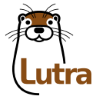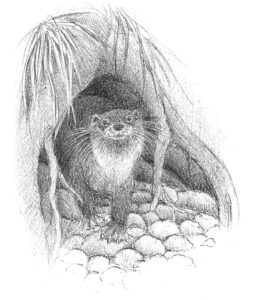
Carnivore, marten, predator
Because of its relatively short limbs and stepping on entire paws , otter looks a little clumsy on land. When jumping, its back is, typically for Mustelids family , curved like a back of a cat. But the otter’s true element, which it masters to perfection, is water; here it displays all the elegance and skillfulness of a water marten. When swimming its body weightlessly and effortlessly glides through the water, it twists and turns and easily pursues the prey. Four webbed paws and strong tail are pushing it with the speed of 15 km/h. Only bubbles on the water surface unveil the agile diver hunting a fish or picking a crayfish from its hollow.
When an otter raises its thick lips and bites into prey, the teeth reveal a true carnivore. Its fangs are a dangerous weapon when in jeopardy. An adult otter needs a daily food intake that is on average a quarter of its body weight. As for its diet, the otter is very adaptable: the biggest part of otter’s diet are different fish species, it is fond of crayfish too. Amphibians (frogs, toads) are a part of otter’s menu according to season. Birds, reptiles, mammals and water insects represent only a fue percentages of otter’s diet. Empty and crashed freshwater shells on sandbanks lead us to conclusion that molluscs are sometimes an important part of its diet as well.
Spraints (otter’s excrements) are very characteristic and not hard to distinguish. They contain mainly fish scales, fish-bones and vertebras, parts of crab extremities, bones of amphibians, remains of birds’ bones and feathers, hair of smaller mammals, reptiles’ skin, hitin parts of insects and vegetal remains. Spraints have a lasting and penetrating smell of fish oil.

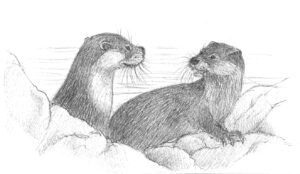

On top of the food chain
The otter adapts its diet to the available types of prey, which are rife and within easy reach in a certain moment. This characteristic classifies the otter among the predators of the highest rank in freshwater ecosystems, on the top of the food chain. Although the otter’s body mass doesn’t reach body mass of large carnivores, the otter has a very similiar role in nature.
In European natural environment otters aren’t affected by natural predators. But the otter’s rank of umbrella species has, with the progress of human civilization and industrial development, has brought the otter more disadvantages than privileges. In developed countries otter has become a victim of intensive farming, industrial effluents and wastes, common pollution of waters and destruction of natural habitats. Otter’s living space has been irreparably changed because of hydromeliorations, regulations of riverbeds, drainage of farming land. The habitats of aquatic organisms have been changed forever, as well as the appearance of the cultured landscape.
We don’t even percieve the disappearance of the otter, often neither the disappearance of fish, amphibians, dragonflies and other water and riparian inhabitants. Only the memory of older hunters and fishermen goes back in time, when people were catching otters in every stream, every lake and every river … Often only the polluted water that runs from a tap warns us of bad quality of aquatic environment. Then it’s already our turn, as we are the last but biggest consumers of clean water. Fenols, chlorinated carbohydrates, heavy metals, nitrates, phosphates and other dangerous substances, that are rinsed in the water with the rests of washing powders, detergents, waste oils, fertilizers, sewage and industrial wastewaters, have a fatal effect on water organisms. Some substances have indirect effect through the prey, where they accumulate, others directly threaten species at the top of the food chain. That’s why the presence of otters indicates the quality of water habitat and the health of broader natural environment. Where the otter still lives, the natural water environment is better preserved and waters are relatively clean, The care for the otter conservation is also destined to the conservation of other animal and plant species in otters living space: kingfisher, reed warbler, marsh frog, moor frog, various fish species, lamprey, crayfish, shells, dragonflies and numerous other species. With the conservation of the otter we are at the same time preserving rich biodiversity of rivers, streams, lakes …
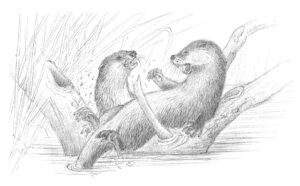
How do we notice, find and track the otter
To observe the otter in nature long hours of persistence and waiting on selected, hidden places are required. Mainly it lives a life hidden to humans and goes hunting mostly at nightfall or before sunrise. So we must pay attention to the signs of its presence, that we find on the river-banks:
- spraints under the bridges and on other exposed places,
- tracks in mud, river sand and snow,
- remains of its food, especially fish, crayfish, clam shells on river-banks,
- entries and ways out on water banks, slides in mud, grass, ice or snow.
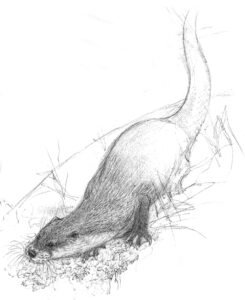
Distribution
Only one species of otter lives in Europe, Eurasian otter (Lutra lutra), which once lived along all running and standing freshwaters. Of all 13 otter species that exist in the world, Eurasian otter has the biggest living range. One can find otter in the coniferous forest of the Carpathians, in the Pannonic plains and even on the seasides on the north and in the south of European continent.
Eurasian otter can be distinguished from other species by its distinctive muzzle shaped in the form of an open W. In otter’s living space, freshwaters, in our country also live muskrats and somewhere nutrias, both american rodents and therefore non autochthonic. Lately they are joined by European beaver, aquatic rodent, that is reconquering our country from the south, along river Sava and upwards the tributaries. When we aren’t sure which aquatic mammal we are observing, we must pay attention to the shape of the tail and animal’s behaviour. Rodents are exclusively herbivores, that’s why we won’t see them chasing the prey.
There is no systematic regional survey that would exactly show the distribution of otter in Slovenia yet. From various field studies, however, we can conclude that otter appears in both the Adriatic and the Danube basin. We rarely follow it on Soča, Idrijca and Vipava.

Goričko – otters paradise in Slovenia
Vital and continuous population of Eurasion otter live also in Goričko area. We can locate otter tracks and spraints almost along every stream and river from Mura, Ledava and Krka to streams Mačkovski, Peskovski, Ratkovski and Kobiljanski potok. At Goričko there are no natural standing waters, therefore water accumulations such as Ledava Lake Ledav near Krašči on Ledava river, Hodoš Lake in Hodoš on stream Dolenskega potok, Lake Križevci on stream Mala Krka and Lake Bukovnica on stream Bukovnica are very important oases of aquatic life that enrich otter’s diet and increase chances for its survival in dry annual periods.
Goričko is the only part of a large hilly landscape that continues to the Hungarian and Austrian sides of the border. Towards the south Goričko ends on diluvial terraces on the left bank of the river Ledava. The northern border of Goričko follows the watershed that separates the river basins of Raba and Mura. These are also the boundaries of the Landscape Park Goričko, which joined parks on the Hungarian and Austrian sides. The otter, as a symbol of endangered but still preserved natural values, will also tie the inhabitants of all three countries in the trilateral park Goričko–Örseg–Raab. because the otter population in Goričko is only a part of greater population that extends across Slovenian borders to the west and east. Water corridors (especially along rivers Ledava and Krka), which connect all three border regions, assure the stability of otter population.
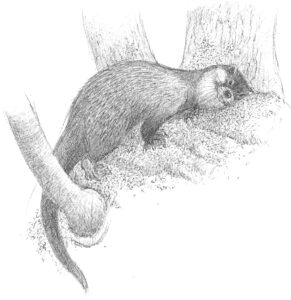 Clean waters are “marked”
Clean waters are “marked”
Otters typicaly live in lowland rivers and streams with a shallow riverbed, which isn’t more than 5 meters wide, has natural, meandering stream and banks overgrown with undamaged, rich vegetation. Especially important are big, old trees with broad root system, that provide convenient resting places and protected places for holts. Numerous piers, bays, peninsulas, pools and sandbanks increase the variety of otter’s habitat and enable the existence of many plant and animal species. With greater biodiversity of freshwater ecosystem the variety of otter’s prey is much bigger. Such ecosystems are balanced and can more easily withstand different changes and pressures.
Favourable living conditions get even better with broadening and connectedness of water network, as well as with standing waters, e.g. lakes, fish ponds and marshes. Otters are tramps. They live a solitary and territorial life, each individual assures itself an adequate territory. But territorial demands are quite large: a male needs approximately 20 km of watercourse (a female 11 km) or 15 km in diameter of standing water (a female 11 km). The size of the territories is subjected to changes (in Sweden their size is twice of that mentioned) and depends above all upon natural conditions which assure the otter the fulfilment of its vital needs.
Younger otters looking for a new living space (teritory) can travel unlikely long distances (even 50 km!), climb watershed ridges and overcome big impediments.
Otters mark the acquired teritories and they defend them from coevals of the same sex. On the borders they tag them with spraints which are mixed with dark, jelly scent marks. More tenacious and frequent markers are males, which let know eventual rivals, that the teritory has already been occupied.
Because of information value of spraints it is important that these are on visible places and that they are preserved as long as possible. Therefore otters deposit spraints on the most exposed points along water banks, preferably on the prominent rock or on the biggest stone, piers, footbridges, water barriers and similar objects, stumps and trunks and also sandbanks at confluences or river mouths. The otter itself also prepares suitable places for depositing spraints by grubbing a heap of sand, mud, soil or grass.
Otters love to visit different objects built on or by the water – such as mills, sawmills, dams – and mark them. But what they prefer to mark are bridges, which lead trails, roads, highways and railroads across otter habitats – watercourses. If planners and constructers had been thinking about the animal’s need when they crossed the landscape with thoroughfares, maybe they arranged dry shelves or even dry infrastructures (made of rocks or concrete). In such cases otters cross the road under the bridge, but they only do it by dry land, because they can find places to mark there. When the openning under the bridge is flooded, the otter is forced to cross the road close by the bridge and it is many times a victim of traffic accidents. In the last decades road traffic is by far the most frequent cause for otter deaths in developed European countries and also in Slovenia. Therefore appropriate arrangement of bridges is an important factor in the protection of otters and water organisms.
Once persecured, now endangered – will the Otter come back?
Times when in Europe otter had been hunted with various traps and poisoned baits, pursued, impaled on points and tridents, hunted with nets and packs of dogs, shot and killed cruelly and barbarously, are a part of a sad history of the species, but we must not forget it. We should learn, that humans with their unsupervised and unrestricted hunting, which is stimulated by high prizes, can critically interfere with the populations of carnivores and even exterminate them. That happened to otter in the past century, when after intensive persecution, in the sixties the species became extremely rare in Europe and in some European countries even became extinct.
In the middle of the twentieth century new, even worse dangers for otter appear. Instead of points, nets and traps came pesticides from the fields, industrial wastewaters with heavy metals, PCBs and other bioaccumulative substances that poison aquatic environment and organisms. The concentration of these substances and their fatal effect is intensified upwards the food chain, until it reaches the otter as a predator of the highest rank – and humans. Although in the seventies otter was already protected in many European countries, the species got more and more rare. But only when it turned out that also humans were threatened, we became alarmed and started questioning what the reasons were. The use of most poisonous biocides is now forbidden (also in Slovenia), but they will remain present in the environment for a long time.
The biggest threath for otters came from the desks of spatial planners. In their wish to meet the ever bigger needs of intensive farming, they were changing the mosaic cultured landscape with meandering, overgrown rivers and streams into monotonous cultured steppes with canals. Their riverbeds are dressed in stone or concrete and their banks were leveled with dredgers. Regardless of aquatic life, watercourses were regulated and drained, banks were clearcutted and even riverbeds were shifted.
In the sixties and seventies the evolution of ecological sciences and the growing awareness regarding nature conservation had brought legal protection of the species Lutra lutra. Precisely otter is a good example that only the protection of a species is not enough for its conservation. It is necessary to protect and preserve otter’s living space – freshwater habitats of all types. Therefore up-todate international agreements and conventions, as well as national legislation direct the conservation of favourable condition of protected animal species together with their natural habitats. But the road to realization of aims concerning the nature conservation is often hard and full of misunderstandings, ignorance and deeply rooted prejudices – and therefore long. In the last years somewhere in Europe the number of otters, after decades of decline, already began to rise and the otter slowly comes back to its ancient habitats. Will we help the otter? At the same time we will also look after other aquatic and riparian residents, biodiversity of freshwater habitats and last but not list – we will look after the key good of the third millenium, water.
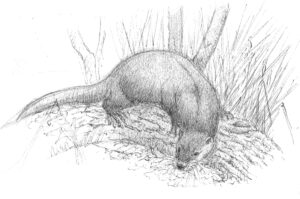
Otter’s identity card
Systematics
Order: Carnivores (Carnivora)
Family: Mustelids (Mustelidae)
Subfamily: Otters (Lutrinae)
Species: Eurasian otter (Lutra lutra)
Body lenght: male 1,20 m, female 1,10 m
Weight: male od 8 do 11 kg, female od 5 do 7 kg
Dental Formula: 3141/3132
Whiskers length: do 25 cm
Digit number: 5/5
Fur density: approx. 50 000 hairs/cm2
PROTECTION OF THE OTTER
In the last decades European or Eurasian otter (Lutra lutra L.) has become target of particular nature conservation efforts, since it is one of five European species of carnivores which had already disappeared from most parts of Central Europe. On the basis of criteria of IUCN – The World Conservation Union the otter is placed in the category V (= vulnerable species). The Council of Europe chose the otter for the symbol of The Convention on the Conservation of European Wildlife and Natural Habitats (Bern Convention which was also ratified in Slovenia in 1999), with the intention of emphazinig the importance of its protection.
Our country has signed more than ten international nature conservation conventions and agreements that directly or indirectly concern the protection of otter and its habitats.

